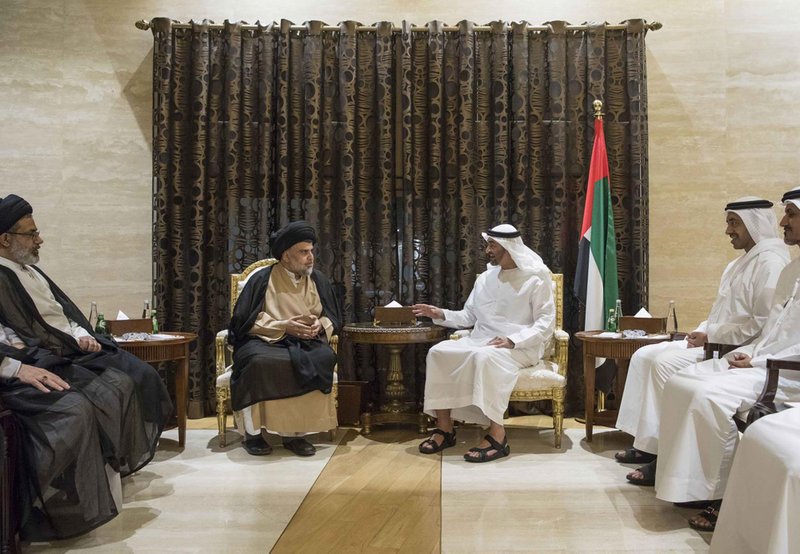
An influential Iraqi Shia cleric, notorious for his followers’ deadly attacks on US troops in Iraq over a decade ago and thought at times to have ties to Iran, has two new stamps in his passport, from the two fiercest Sunni critics of Tehran in the Gulf.
Muqtada al-Sadr’s trips to Saudi Arabia and the United Arab Emirates come as the two nations want to limit Iran’s influence in the wider Middle East, especially with Iranian-backed Shia militias leading the fight against the Islamic State group on Iraqi battlefields.
Meanwhile, the chameleonic cleric hopes to cement his own standing ahead of Iraq’s parliamentary elections next year, part of his makeover from a militia warlord whose fighters battled American forces to an Iraqi nationalist who can fill Baghdad’s streets with his protesting followers.
How far any possible alliance between al-Sadr and the Gulf Arab countries could go remains to be seen, though photos of the black-turbaned Shiite cleric meeting with Sunni rulers already has stirred speculation in Iran.
“Why has Muqtada al-Sadr sold himself to the Al Saud?” the hard-line Iranian newspaper Keyhan bluntly asked after his visit, referring to Saudi Arabia’s royal family. The paper also warned that if al-Sadr continued on this path, “his popularity will fall and he will become an isolated person.”
Such harsh criticism from Iran would have been unthinkable in the years immediately following the 2003 US-led invasion of Iraq.
While Sunni Muslims represent the world’s principal branch of Islam, Shias are the majority in Iraq. Neighboring Iran has had a government overseen by Shia clerics since its 1979 Islamic Revolution. Saddam Hussein’s Sunni-dominated government massacred Shiites after the 1991 Gulf War and continued imprisoning, torturing and executing others up to his overthrow.
Al-Sadr, the son of a prominent Shia cleric assassinated in a 1999 attack believed to be organized by Saddam, quickly organized Shia dispossessed under Saddam against the American occupation.
“The little serpent has left and the great serpent has come,” al-Sadr told CBS News’ “60 Minutes” program in 2003.
Saddam loyalists and Shia extremists alike would soon fight an insurgency against the American forces. Al-Sadr’s Mahdi Army militia fought American forces throughout much of 2004 in Baghdad and other cities.
Al-Sadr’s forces are believed to have later taken part in the sectarian killings between Shias and Sunnis that plagued Iraq for several years after the bombing of one of the holiest sites in Shia Islam. Al-Sadr left for Qom, a holy Shia city in Iran, for religious studies around the time that his forces accepted a cease-fire in the 2008 battle of Basra, in southern Iraq.
Since that time much has changed.
Al-Sadr’s followers have taken part in Iraqi military offensives against the Islamic State group in Tikrit and other cities. He has organized rallies against government corruption, including breaching the fortified Green Zone in Baghdad, the highly secure area housing government offices and many foreign embassies.
On July 30, al-Sadr traveled to Saudi Arabia to meet with Crown Prince Mohammed bin Salman, the next in line to the throne. The state-run Saudi Press Agency published a photograph of King Salman’s son smiling next to the cleric, only saying the two “reviewed the Saudi-Iraqi relations and a number of issues of mutual interest.”
In the UAE, al-Sadr met on Sunday with Sheikh Mohammed bin Zayed Al Nayhan, Abu Dhabi’s powerful crown prince, and other officials.
“Experience has taught us to always call for what brings Arabs and Muslims together, and to reject the advocates of division,” Sheikh Mohammed said in a statement carried on the state-run WAM news agency.
Anwar Gargash, the Emirati minister of state for foreign affairs, tweeted after the meeting that it was part of an effort to “build bridges” between the Gulf Arab nations and Iraq.
“Our ambition is to see a prosperous, stable Arab Iraq,” Gargash wrote. “The challenge is great and the prize is bigger.”
Using “Arab” to describe Iraq is no accident for the UAE, which opposed the 2003 American invasion. Both the UAE and Saudi Arabia want to limit Shiite-ruled Iran’s power in Iraq.
“There are serious questions about how to help encourage Iraqi stability and minimize Iranian influence in the country,” said Lori Plotkin Boghardt, a former US intelligence official who now is a fellow at The Washington Institute for Near East Policy. “Building ties with someone like al-Sadr is part of the Saudis’ and Emiratis’ answer to this.”
One of the biggest question marks ahead for Iraq is what happens after the war against the Islamic State group.
Shia militias advised by members of Iran’s paramilitary Revolutionary Guard have proved to be among the most effective ground forces in the fight against IS. Disarming or incorporating the groups into existing security forces likely would be a major challenge for the national government.
Al-Sadr, already a respected Shiite cleric with a massive base of followers, demanded in March that Shia militias disband, saying only Iraqi national forces should hold territory in the country. Though many among the militias disagree, saying they have proven their credentials in battle against IS, al-Sadr’s stand could provide Baghdad with the cover it needs to do so.
“This would be, of course, music to the Gulf countries’ ears,” said Fanar Haddad, a senior research fellow at the Middle East Institute at the National University of Singapore.
For al-Sadr, whose loyalists represent one of the biggest blocs in Iraq’s parliament, his foreign trips burnish his credentials as an Iraqi leader. However, it remains unclear what he wants, and whether any tilt toward the Sunni Gulf countries truly would represent a total break with Iran for the Iraqi nationalist.
“It shows he has options,” Haddad said.




